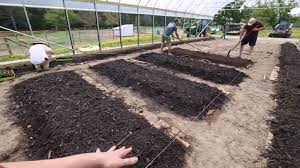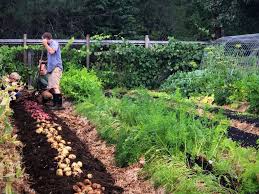Starting a No-till garden means not digging up the soil. Instead of turning the soil, you leave it undisturbed. This helps to keep the soil structure intact. No-till gardening is like letting the earth be as it is, without disturbing its natural layers.
When you start a No-till garden, you are choosing a method that promotes soil health. The soil becomes a home for many tiny creatures like worms and insects. These creatures help to create a balance in the soil, making it a good place for plants to grow.
In a No-till garden, the top layer of the soil, called the ‘mulch,’ is important. This layer can be made from things like leaves, straw, or other organic materials. The mulch protects the soil from the harsh sun and helps to keep it moist. It acts like a natural blanket for the earth, keeping it cozy for the plants.
One of the benefits of starting a No-till garden is that it reduces erosion. When you don’t disturb the soil, it’s less likely to wash away during heavy rain. This is good for the environment and helps to keep your garden in place.
Weeds also have a harder time taking over in a No-till garden. The layer of mulch makes it difficult for weed seeds to sprout and grow. This means less time spent pulling weeds and more time enjoying your garden.
Starting a No-till garden might seem different at first, especially if you’re used to turning the soil every season. But as you let nature do its work, you’ll see the benefits. Your garden will become a thriving ecosystem where plants, insects, and soil work together in harmony.
In essence, starting a No-till garden is like giving the soil a chance to live its natural life. It’s a gentle approach to gardening that lets Mother Nature take the lead. So, if you’re looking for a way to cultivate a healthy garden while respecting the earth, consider starting a No-till Garden – a garden that works with nature, not against it.
Read Also: The Different Types of Snail Food / Snail Feed
How to Start a No-Till Garden

Starting a no-till garden is easy and beneficial for your plants and the environment. No-till gardening means you don’t disturb the soil by digging or turning it over. Instead, you build on top of the existing soil, creating a healthier environment for your plants.
Here’s a simple guide on how to start your own no-till garden;
1. Choose a Suitable Location: Find a sunny spot for your garden. Most plants love sunlight, so pick a location that gets at least 6 hours of direct sunlight each day.
2. Prepare the Ground: Clear the area of weeds and debris. You don’t need to dig or till the soil. Just remove any large obstacles that may hinder your plants’ growth.
3. Layer with Newspaper or Cardboard: Lay down a thick layer of newspaper or cardboard over the cleared area. This helps suppress weeds and creates a barrier between your plants and the existing grass or weeds.
4. Add Compost: Spread a generous layer of compost over the newspaper or cardboard. Compost enriches the soil with nutrients and improves its structure.
5. Mulch for Moisture Retention: Cover the compost with a layer of organic mulch, such as straw or wood chips. Mulch helps retain moisture, suppresses weeds, and regulates soil temperature.
6. Plant Your Seeds or Seedlings: Make small openings in the mulch and newspaper/cardboard layers to plant your seeds or seedlings. Follow the recommended spacing for each plant.
7. Water Regularly: Water your garden regularly, especially during dry periods. The mulch will help retain moisture, reducing the need for frequent watering.
8. Monitor and Weed: Keep an eye on your garden and pull out any weeds that manage to poke through. The newspaper or cardboard should deter most weeds, making maintenance easier.
9. Apply Mulch as Needed: Replenish the mulch layer as needed to maintain a thickness of 2-4 inches. This ensures ongoing weed suppression and moisture retention.
10. Enjoy the Benefits: Sit back and enjoy the benefits of your no-till garden. Over time, the soil structure will improve, and your plants will thrive without the need for disruptive digging.
Remember, the key to a successful no-till garden is patience. It may take some time for the soil ecosystem to establish itself, but the long-term benefits are well worth the wait. Happy gardening!
Read Also: How to Choose a Snail Farming System
Benefits of Starting a No-till Garden

Starting a no-till garden comes with various benefits that contribute to both the health of your plants and the overall sustainability of your gardening practices. Here are some key advantages:
1. Soil Health: No-till gardening preserves the natural structure of the soil. By avoiding disruptive tilling, beneficial microorganisms and earthworms thrive, enhancing soil fertility and structure.
2. Moisture Retention: The use of mulch in no-till gardening helps retain moisture in the soil. This reduces the need for frequent watering, making your garden more resilient during dry periods.
3. Weed Suppression: The initial layer of newspaper or cardboard, combined with mulch, acts as a barrier that suppresses weed growth. This minimizes the competition for nutrients and sunlight, allowing your plants to flourish.
4. Nutrient Retention: The organic matter, such as compost, added to a no-till garden contributes to nutrient-rich soil. This provides a continuous supply of essential nutrients for your plants, promoting healthy growth.
5. Erosion Prevention: No-till gardening prevents soil erosion by maintaining the structure of the topsoil. The mulch layer protects against water runoff, preserving the integrity of your garden’s foundation.
6. Time and Labor Savings: Without the need for regular tilling, no-till gardening reduces the amount of time and physical effort required to maintain your garden. This makes it a more sustainable and practical option for busy gardeners.
7. Carbon Sequestration: No-till practices contribute to carbon sequestration in the soil. The organic matter added to the garden traps carbon, helping mitigate climate change by reducing carbon dioxide in the atmosphere.
8. Biodiversity Support: Healthy, undisturbed soil in a no-till garden creates a favorable environment for a diverse range of beneficial insects and organisms. This biodiversity can contribute to a more resilient and balanced ecosystem.
9. Cost Savings: No-till gardening often requires fewer inputs such as fuel for tillers and less need for synthetic fertilizers. This can result in cost savings over time, making it an economically viable choice.
10. Long-Term Sustainability: Adopting a no-till approach is a sustainable gardening practice. It promotes environmental conservation by minimizing soil disturbance and reducing the ecological footprint of your gardening activities.
By embracing no-till gardening, you not only promote the well-being of your plants but also contribute to a more sustainable and resilient ecosystem in your backyard.
Read Also: The Essential Guide to Biodiversity Waste Disposal Near You

